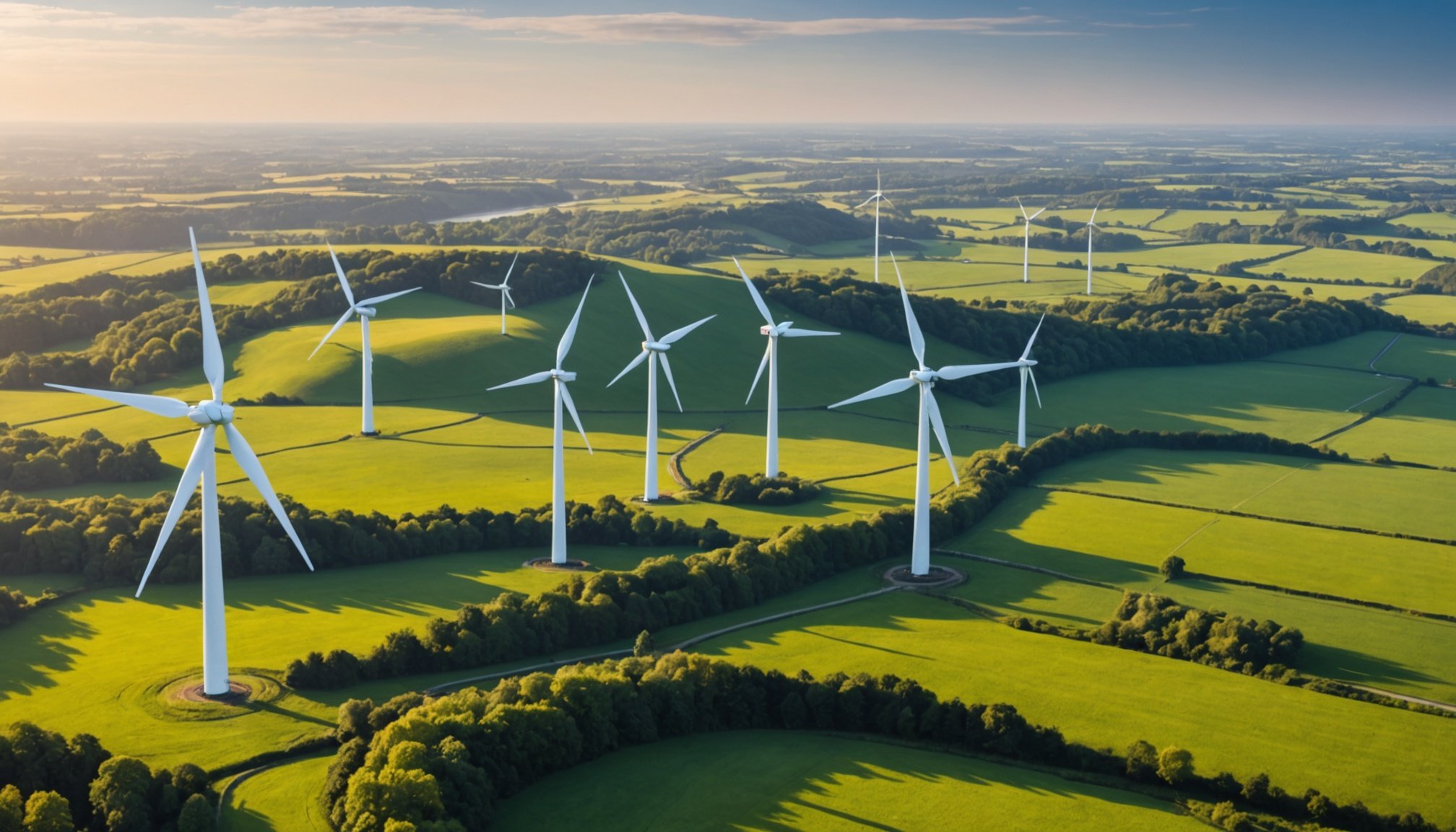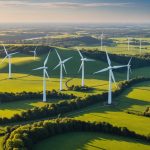Unveiling the Key Trends Steering the Future of Renewable Energy in the UK
As the world grapples with the challenges of climate change, the UK is at the forefront of a revolutionary shift towards renewable energy. 2024 has been a landmark year, marking the first full year where low-carbon renewables have generated more electricity than fossil fuels. Here, we delve into the key trends that are shaping the future of renewable energy in the UK.
The Rise of Renewable Power: A New Era in Energy Generation
In 2024, the UK achieved a significant milestone: low-carbon renewable power, comprising wind, solar, and hydropower, generated 37% of the country’s electricity, surpassing the 35% contributed by fossil fuels[1][2].
Also read : Mastering AI Recruitment: Crucial Legal Tips for UK Companies to Thrive
Wind Power: The Emerging Champion
Wind power is on the cusp of becoming the single largest source of UK power. In 2024, wind generated 29% of the UK’s electricity, just shy of the 30% produced by gas. This growth is largely attributed to the increase in onshore wind capacity, with a notable 23% rise in onshore wind generation in the first three quarters of the year. The completion of the Viking Wind Farm on the Shetland Islands, adding 443 MW of new capacity, has been a significant contributor to this surge[1][2].
Decline of Fossil Fuels: A Rapid Shift Away from Traditional Energy Sources
The decline of fossil fuels in the UK energy mix has been dramatic. Since 2000, fossil fuel generation has fallen by two-thirds, with coal power virtually eliminated by October 2024. Gas power, too, has seen a significant decline, with a 13% reduction in 2024 compared to the previous year. This drop is driven by increased renewable capacity, lower electricity demand, and cheaper power imports[1][2].
Additional reading : Key Considerations for UK Tech Startups in Choosing the Perfect Co-Working Space
Key Statistics:
- Fossil Fuel Generation: 35% of UK electricity in 2024 (97 TWh), down from 46% in 2021.
- Coal Power: Reduced to zero by October 2024.
- Gas Power: 30% of UK electricity in 2024 (85 TWh), down from 34% in 2023.
Solar and Hydro Power: Mixed Fortunes but Promising Futures
While wind power has been the star performer, other renewable sources have also shown significant trends.
Solar Power: Challenges and Opportunities
Solar generation saw a 9.5% drop in 2024, despite the addition of 2.1 GW of new capacity. This decline was primarily due to a 20% decrease in average sun hours. However, the long-term outlook remains positive, with solar expected to play a crucial role in the UK’s energy mix by 2025[2].
Hydro Power: A Surprising Surge
Hydro generation surged by 38% in 2024, driven by a significant increase in rainfall. This highlights the potential of hydro power to contribute to the UK’s renewable energy goals, especially during periods of high rainfall[2].
The Role of Technology and Innovation in the Energy Sector
Technology and innovation are driving the transition to a sustainable energy future in the UK.
Energy Storage: A Critical Component
Energy storage systems, such as batteries, are becoming increasingly important as the UK integrates more intermittent renewable sources into the grid. By 2025, businesses are expected to benefit from a more reliable and flexible grid, allowing for better management of energy consumption and storage[3].
Grid Modernisation: Unblocking the Path to Clean Energy
The UK’s energy grid is undergoing significant modernisation. The government’s plan to clean up the dysfunctional grid system, speed up planning decisions, and expand the renewable auction process aims to unblock billions of pounds in investment in clean energy projects. This includes prioritising critical energy infrastructure and ending the ‘first-come-first-served’ system[4].
Economic and Job Creation Impacts: A New Era of Industrial Growth
The transition to renewable energy is not just an environmental imperative but also an economic opportunity.
Investment and Job Creation
The UK’s clean power mission is expected to unlock £40 billion of investment annually in homegrown clean power projects and infrastructure. This will create thousands of skilled jobs across the country, including roles for engineers, welders, and mechanics. The East Coast Cluster, a carbon capture project in Teesside, is set to start construction in mid-2025, further boosting job creation in the North East of England[4].
Sectoral Growth: From Manufacturing to AI
The clean energy sector is driving growth across various industries, including AI, data centres, and manufacturing. As the UK accelerates its transition to clean energy, it is reindustrialising the country and creating new economic opportunities[4].
Challenges and Opportunities: Navigating the Path to Net Zero
While the progress is promising, there are challenges to overcome on the path to a net-zero future.
Biomass and Carbon Emissions
Biomass, despite being a renewable source, is a major emitter of carbon. The UK needs to address this issue to ensure that its renewable energy mix is truly sustainable. The government’s focus on green hydrogen and other clean technologies will be crucial in mitigating these emissions[2].
Grid Limitations and Payment Cutoffs
Grid limitations and payment cutoffs, particularly in Scotland where much of the UK’s onshore wind capacity is located, pose significant challenges. These issues need to be addressed through more offshore projects and reliable financial backing to ensure the continued growth of wind generation[2].
Practical Insights and Actionable Advice for Businesses and Consumers
As the energy landscape evolves, businesses and consumers need to adapt to leverage the benefits of renewable energy.
Investing in Energy Efficiency
Businesses that invest in energy efficiency or renewable energy can see substantial long-term savings. On-site renewable energy generation, such as solar panels, and energy storage systems can help smooth out fluctuations in supply and reduce costs[3].
Diversifying Energy Sources
Consumers and businesses should diversify their energy sources to reduce dependence on fossil fuels. This includes exploring green hydrogen, solar power, and other renewable technologies to ensure a sustainable energy future[3].
Future Outlook: What to Expect in 2025 and Beyond
As we look ahead to 2025 and beyond, several trends are set to shape the future of renewable energy in the UK.
Renewable Energy Dominance
By 2025, renewable energy is expected to make up close to half of the UK’s energy supply, driven by offshore wind, solar, and green hydrogen. The UK is set to become the 6th largest producer of wind energy in the world, further solidifying its position as a leader in renewable energy[3].
Quantum Computing and Advanced Technologies
While not directly related to current renewable energy generation, quantum computing and other advanced technologies will play a crucial role in optimizing energy systems and improving the efficiency of renewable energy integration into the grid. These technologies will help in predicting energy demand, managing energy storage, and enhancing the overall resilience of the energy system[3].: Embracing a Sustainable Energy Future
The UK’s journey towards a sustainable energy future is marked by significant milestones and promising trends. As we move forward, it is crucial to address the challenges and leverage the opportunities presented by renewable energy.
Key Trends to Watch:
- Rise of Wind Power: Wind is set to become the largest single power source in the UK.
- Decline of Fossil Fuels: Fossil fuel generation is falling rapidly, with coal power eliminated and gas power decreasing.
- Technological Innovation: Energy storage, grid modernisation, and advanced technologies like quantum computing are driving the transition.
- Economic Growth: The clean energy sector is creating new investment opportunities and jobs.
- Challenges and Opportunities: Addressing biomass emissions, grid limitations, and ensuring reliable financial backing for renewable projects.
As Jess Ralston, Head of Energy at the Energy and Climate Intelligence Unit (ECIU), noted, “Accelerating the rollout of renewables will stabilise prices and clean technology like electric heat pumps will increasingly run off British wind and solar in contrast to gas boilers which will increasingly be run off foreign gas imports.”[4]
The future of renewable energy in the UK is bright, and with continued innovation, investment, and policy support, the country is well on its way to achieving a sustainable, net-zero energy future.
Detailed Bullet Point List: Key Actions for Businesses and Consumers
- Invest in Energy Efficiency: Implement energy-efficient practices and technologies to reduce energy consumption.
- Diversify Energy Sources: Explore renewable energy sources such as solar, wind, and green hydrogen to reduce dependence on fossil fuels.
- On-Site Renewable Generation: Consider installing solar panels or other on-site renewable energy systems.
- Energy Storage Systems: Invest in energy storage solutions like batteries to manage energy supply fluctuations.
- Grid-Balancing Initiatives: Participate in grid-balancing initiatives to optimize energy use and reduce costs.
- Stay Informed: Keep up-to-date with the latest trends and policies in the renewable energy sector to make informed decisions.
- Support Renewable Projects: Advocate for and support the development of new renewable energy projects in your community.
Comprehensive Table: Comparison of Energy Sources in the UK (2021 vs 2024)
| Energy Source | 2021 Generation (%) | 2021 TWh | 2024 Generation (%) | 2024 TWh |
|---|---|---|---|---|
| Fossil Fuels | 46% | 133 TWh | 35% | 97 TWh |
| Low-Carbon Renewables | 27% | 77 TWh | 37% | 103 TWh |
| – Wind | 20% | 57 TWh | 29% | 82 TWh |
| – Solar | 4% | 11 TWh | 4% | 11 TWh |
| – Hydro | 3% | 9 TWh | 4% | 11 TWh |
| Biomass | 8% | 23 TWh | 8% | 23 TWh |
Quotes from Key Figures
- Energy Secretary Ed Miliband: “The Clean Power Action Plan will be considered a landmark moment for the clean energy sector. Not only do investors have a clear government target of establishing a lowest cost electricity system dominated by wind and solar, but they now have a roadmap to achieving it.”[4]
- Ofgem CEO Jonathan Brearley: “Ofgem’s job is to protect consumers at every stage so that the transition is achieved at the fastest rate and lowest price possible. The clean power plan makes clear there are tough trade-offs, which is why it’s vital that the government brings the public, businesses and industry with it on every step of the journey.”[4]
- Jess Ralston, Head of Energy at ECIU: “The UK has paid the price for over-reliance on expensive gas over the past few years and the crisis is not over yet. Accelerating the rollout of renewables will stabilise prices and clean technology like electric heat pumps will increasingly run off British wind and solar in contrast to gas boilers which will increasingly be run off foreign gas imports.”[4]











